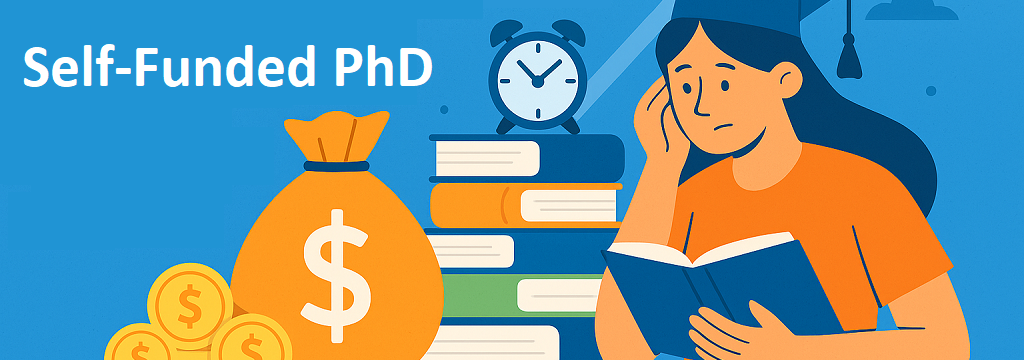
Pursuing a PhD is a significant intellectual and financial commitment. When students are unable to secure full funding for PhDs, self-financing often becomes the only viable path. Beyond the financial burden from self-funded insurance, research fees, and living costs, a self-funded PhD also demands resilience, discipline, and sustained effort. Although a self-funded PhD offers greater independence, many students must juggle employment, coursework, and personal responsibilities to reach their academic goals. In this blog, we explore the realities of self-funding a PhD, examining the associated costs, challenges, and key considerations.
Understanding Self-Funding for a PhD
Covering tuition, living expenses, and research costs without institutional support is known as pursuing a self-funded PhD. Unlike funded programs, where stipends or assistantships help alleviate the financial burden, self-funding places full responsibility on the student. It is a path that demands careful planning and unwavering commitment. Some students self-fund because they missed funding deadlines or received only partial support from a PhD supervisor or department. Others choose this route intentionally, valuing the independence and flexibility it offers. In any case, self-funding entails significant financial risk, often amounting to tens of thousands of dollars.
The Financial Breakdown
Tuition, books, research supplies, and living expenses are some of the expense categories associated with self-funding a PhD. The annual cost of tuition alone may vary from 10,000 to 50,000 USD, contingent upon the country, university, and program. The sum increases significantly when housing, food, and travel are included. Research costs, conference costs, software licenses, and lab equipment can quickly deplete savings. Self-funding a PhD often feels like a solo journey, with the student bearing most or all of the financial risk. In contrast, self-funded insurance, particularly in group settings, typically distributes costs and risks among participants, offering a built-in safety net.
University Tuition and Fees
Tuition is one of the largest expenses in a self-funded PhD journey, and it varies widely by country. In the USA, annual tuition can range from 20,000 to 50,000 USD for international students at top universities. The UK typically charges 15,000 to 25,000 GBP (~19,000–32,000 USD) per year. In Australia (or Canada), tuition for international PhD students is often between 15,000 and 35,000 AUD (or CAD) per year. Germany and France, however, offer a more affordable path as public universities usually charge only administrative fees of 250–600 EUR per semester, even for international students. While some programs in low-cost countries are taught in English, students must still account for visa fees and documentation costs.

PhD Research Fees
Research-related expenses can quickly add up, especially in lab-based or fieldwork-heavy disciplines. These include costs for lab equipment, materials, chemicals, field visits, and experiment-related services. In countries like the USA, Australia, and Canada, these costs can be substantial and are often not included in tuition. In contrast, Germany and France may offer more subsidized access to university research facilities. Students in the UK may also face “bench fees” of 1,000 to 5,000 GBP annually, depending on the nature of the research. Self-funded students must ask universities upfront about these hidden or additional charges.
Living Costs (Rent, Utilities, Food, and Transportation)
Living expenses vary dramatically based on location and lifestyle. In cities like New York, London, Sydney, and Toronto, rent alone can exceed 1,000–1,500 USD per month for a single student. Utilities, food, and local transportation can add another 500–1,000 USD per month. On the other hand, cities in Germany (e.g., Leipzig, Dresden) or France (e.g., Lyon, Lille) offer more affordable living, often totaling under 900–1,200 EUR per month. Students should also account for visa requirements related to proof of financial solvency (e.g., Germany requires proof of about 11,000 per year EUR).

Read articles about the student living costs in USA and the student living expenses in UK to learn how to manage your costs in these countries. Freelance or part-time work can help defray expenses, but it requires time management. For example, online teaching fits quite nicely with school timetables. Savings are essential to the success of the self-funding path. Putting money away years in advance creates a safety net against unforeseen costs. Additionally, proactive investment helps mitigate future risks. Family support is also helpful. Some make self-funding a community endeavor by pitching their studies to funders. These strategies demonstrate the inventiveness that self-funding encourages.
Self-funded Insurance
The term “self-funded” is also used in the insurance world, particularly in corporate healthcare settings, where employers pay claims directly. Self-funded insurance is a strategy where individuals or businesses set aside money to cover their healthcare expenses, rather than relying on a traditional insurance policy. Unlike a self-funded PhD, which places all the financial burden on one individual, self-funded insurance usually spreads risk across a group. This comparison highlights the isolating nature of self-funded education as there is no financial buffer or shared safety net unless a student has personal support, savings, or sponsorship.
Health insurance is a mandatory and often overlooked cost for international PhD students. In the USA, plans can cost 1,500–3,000 USD annually, depending on coverage. In Australia and Canada, international students are typically required to enroll in government-approved plans, which cost around 600 to 900 USD per year. In Germany, students can join public health insurance systems for around 100–120 EUR per month, while France offers free or low-cost public health coverage under the social security system. In the UK, international students pay the Immigration Health Surcharge (IHS), currently 780 GBP per year (as of 2025).

Unexpected Costs
Self-funded students must prepare for hidden or surprise expenses. These might include visa renewals, medical emergencies not covered by insurance, emergency flights home, laptop or equipment repairs, or costs related to family obligations. In some countries, such as Australia and Canada, students are also required to maintain a minimum bank balance to meet visa regulations. The purpose of this requirement is to ensure students can support themselves without becoming a burden on Australian or Canadian social services or being forced into exploitative situations due to financial hardship. Planning a financial buffer of at least 10–20% over the estimated budget is advisable.
Comparing Self-Funding to Other Options
Self-funded PhD positions differ significantly from fully or partially funded programs. Fully funded PhD positions are typically supported by fully funded scholarships, studentships, or fellowships provided by governments and organizations (such as the Marie Curie PhD program), and graduate assistantships (RA and TA) offered by universities, institutions, or research supervisors through. Depending on the country, these roles often provide an annual stipend ranging from 20,000 to 45,000 USD, easing the financial burden on students. In contrast, self-funded positions offer more flexibility and independence, as students are not bound by the obligations that often come with funded roles.
While loans can help cover the cost of a PhD, they also lead to debt. Self-financing avoids this but requires either substantial upfront resources or income from part-time work. This approach is similar to self-funded health insurance, which eliminates long-term payments but demands higher initial costs. Hybrid models, such as combining self-funding with partial scholarships, also exist and offer a balance of autonomy and financial support, although they are relatively rare. Each pathway involves trade-offs, but choosing to self-fund a PhD reflects a particularly bold and determined commitment.

The Emotional and Professional Rewards
Access to professions with higher earning potential, like academia, business, or entrepreneurship, is made possible by a PhD. Self-funding a PhD presents both a financial and an emotional barrier. Resilience, which is fueled by the satisfaction of overcoming obstacles, is valued by coworkers and employers. Along with their degree, graduates take home a story of perseverance. After investing in her engineering degree, which she financed for herself, Sarah was offered a six-figure position. However, self-funding a PhD carries several risks, such as debt, fatigue, and an oversupplied labor market. It is a bet where personal motivation determines the outcome and relies on calculated risk.
The stress of balancing education and money can also be detrimental to one’s emotional well-being. Opportunity costs are substantial when self-funding. If a consistent income is sacrificed for years, life milestones like home ownership and starting a family may be delayed. These concessions underscore the true cost of a self-funded PhD. For instance, Navid left his 60,000 USD job to pursue his doctorate. Despite the years of hardship, he saw self-funding as an investment in his future. His narrative exemplifies the conflict between adversity and hope that this path involves.
Who Chooses Self-Funded PhD Positions?
Self-funding a PhD attracts many people, including those in niche fields with limited support, international students, and those changing careers. Each group faces different challenges, such as fewer funding options or visa restrictions. What unites them is the willingness to take a risk on themselves. Take Lili, an international student in the UK who did not qualify for most scholarships. She had to work night shifts to pay for her PhD. Her story is like many others who push through difficulties with determination. Self-funded PhDs also appeal to people who want more control. They pursue a research project without worrying to follow financial sources’ rules. But this freedom often comes with a heavy price.
Conclusion
Self-funding a PhD is a risky decision that combines opportunity and sacrifice. It is not for everyone and many students are put off by the unpredictability and financial pressure. For those who do, however, it is a tribute to perseverance and foresight. There are clear similarities to self-funded insurance: both require finances, risk tolerance, and planning. Whether via labor, money, or creativity, self-funding transforms lives. It serves as a reminder that our willingness to invest is reflected in education, just like in any other investment. For many candidates, a self-funded PhD is still a feasible but difficult option. If you’re thinking about it, balance the potential for a PhD obtained on your terms with the associated expenses.
Frequently Asked Questions (FAQs)
What does it mean to pursue a self-funded PhD?
It means the student covers all costs, i.e., tuition, living, self-funded insurance, PhD research, and many others, without institutional financial support.
How much does a self-funded PhD typically cost?
Varying by country and lifestyle, costs can range from 20,000 to 50,000+ USD per year, including tuition, research fees, and living expenses. Additional hidden costs such as insurance, visa fees, and unexpected expenses should also be considered. It demands careful budgeting and strong personal commitment.
Why do students choose to self-fund their PhD?
Some choose self-funding for the independence it offers, or they were unsuccessful in securing funding. It is common among career changers, international students, or those in niche research areas with limited scholarships.



0 Comment